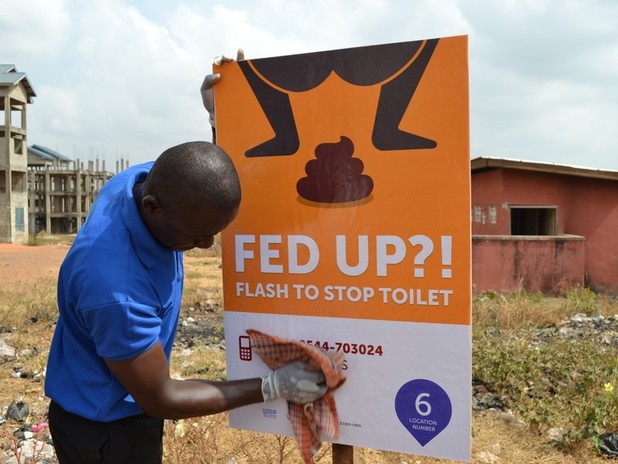March 28, 2013
Pivoting prototypes, a new website, and 1,000 photos transformed into a two-minute movie. IDEO.org's Molly Norris provides a Clean Kumasi update four months into the project.
The massive mound of waste could not be missed. Neither could the fact that it was expanding. This dump was glaring and located right next to a school, the community's orange clay football pitch, and the shared passenger van stop that serves as a public transport hub. Wait a few minutes -- no more -- and you could see children and adults add to the unhygienic dump by “easing themselves” directly or chucking plastic bags full of human feces or other solid waste onto the pile.
The reasons this site has emerged as a waste dump are complex and borne of necessity. To be utterly brief, in-home sanitation is not possible for these low-income renters and public toilets don't meet their needs in terms of cost, cleanliness, hours of operation, safety, and accessibility. Compounding this problem, most public toilets ban children as they are seen as too messy.
When we began our Clean Kumasi project, this dumping site and all the others we visited seemed daunting. Yet, within the first two weeks of prototyping, community members came together to organize an initial cleanup of the site. Residents took rakes and removed waste from the edges of the site. This created much-needed breathing room between where people lived and the dump. Some weeks later, a trash receptacle was installed by the local government and the dumping site has significantly diminished. While these cleanup efforts are small in comparison to the magnitude of the dumping site (and the magnitude of the problem at other sites around Kumasi), they were more than we expected or had originally planned to measure.
Our first Clean Kumasi prototype -- a platform for creating community-based campaigns eradicating open defecation using digital tools to mobilize collective action -- launched in late November. Based upon everything we learned during that first stage of the project, we re-launched a new and improved Clean Kumasi prototype this January.
To see if that new prototype is working, we're following ten households in our small test neighborhood in Kumasi, for nine months. We're checking to see how their knowledge of and practices around sanitation change over the coming months. We want to know if their community is becoming a healthier place to live with less open defecation.
Here are the main changes we've made to Clean Kumasi and the impact we've seen so far (beyond the surprising trash receptacle).
SMS Becomes Voice: We’ve replaced the original SMS texting system with a voice-based system. Residents now “flash” (call and hang up) the Clean Kumasi system and it calls them back to tell them about the Clean Kumasi campaign in their neighborhood. Once a user is enrolled in the system, users are updated when there are meetings and demonstrations near them. It's free to flash and many residents are well versed in this practice as we saw it widely used during our time in the field in Kumasi.
Facebook to Microsite: Our original Clean Kumasi prototype used a resident-facing Facebook app. The connection between the sanitation situation in the community and what was displayed on the Facebook application was too hard to follow for the residents of Kumasi that tested our original prototype. At the same time, web analytics showed us that people were accessing the Facebook app from all around the world, even as we struggled to get our primary audience of neighborhood residents in Kumasi to use the Facebook app. As part of our new prototype, we replaced the Facebook app with a microsite directed to a global audience, CleanKumasi.org. The site contains live data feeds from the Clean Kumasi project and all data is downloadable and open source as a means for sharing our results with the humanitarian sector and progressing the community-led total sanitation (CLTS) methodology.
In-Person Trumps All: During our first Clean Kumasi prototype, we discovered that community action was best triggered by face-to-face meetings. Technology can facilitate these meetings to happen, but cannot be the primary tool for action. We changed our second Clean Kumasi prototype to be about mobilizing in-person action. To do so, we created a suite of organizer tools that can be used to collect inputs from in-person meetings and enroll people without technology. With the new prototype, digital tools are used by “already motivated” individuals to rally additional public support to the sanitation cause.
Setting Up Indicators: We've been following our cohort of ten Kumasi households and monitoring our other data streams, such as the analytics that pour out of the semi-digitized Clean Kumasi platform and its microsite. For measurement and evaluation, we've been working with the experts at USAID's Development Innovation Ventures division and our NGO partner on the ground in Kumasi, Water and Sanitation for the Urban Poor (WSUP). The top-level indicators we've established include increased use and maintenance of public toilets, as well as attitudinal indicators around awareness of the connection between open defecation and disease. Our latest numbers are from before the re-launch of the new prototype and we've seen the stirrings of change, but nothing too quantifiable or significant yet. We’re excited for the next round of survey results and we'll keep you posted! In the meantime, check out the data on CleanKumasi.org and follow our progress yourself.
***
This project is made possible by the generous support of the American people through the United States Agency for International Development (USAID). The contents of this story are the responsibility of IDEO.org and do not necessarily reflect the views of USAID or the United States Government.











